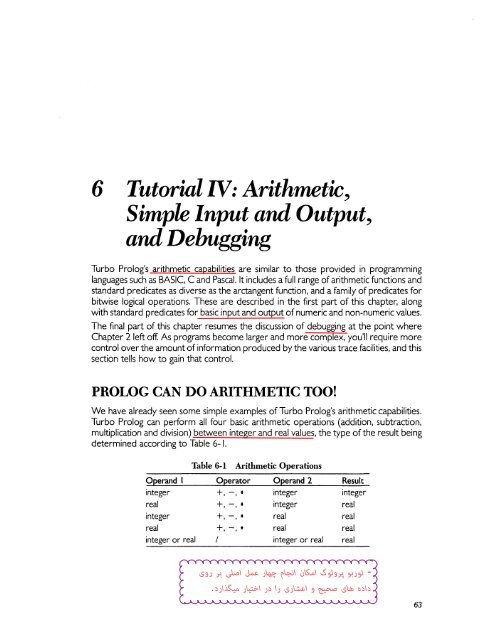Turbo Prolog
Turbo Prolog
Turbo Prolog
Create successful ePaper yourself
Turn your PDF publications into a flip-book with our unique Google optimized e-Paper software.
6 Tutorial IV: Arithmetic,<br />
Simple Input and Output,<br />
and Debugging<br />
<strong>Turbo</strong> <strong>Prolog</strong>'s arithmetic capabilities are similar to those provided in programming<br />
languages such as BASIC, C and Pascal. It includes a full range of arithmetic functions and<br />
standard predicates as diverse as the arctangent function, and a family of predicates for<br />
bitwise logical operations. These are described in the first part of this chapter, along<br />
with standard predicates for basic input and output of numeric and non-numeric values.<br />
The final part of this chapter resumes the discussion of debugging at the point where<br />
Chapter 2 left off. As programs become larger and more complex, you'll require more<br />
control over the amount of information produced by the various trace facilities, and this<br />
section tells how to gain that control.<br />
PROLOG CAN DO ARITHMETIC TOO!<br />
We have already seen some simple examples of <strong>Turbo</strong> <strong>Prolog</strong>'s arithmetic capabilities.<br />
<strong>Turbo</strong> <strong>Prolog</strong> can perform all four basic arithmetic operations (addition, subtraction,<br />
multiplication and division) between integer and real values, the type of the result being<br />
determined according to Table 6-1.<br />
Table 6-1 Arithmetic Operations<br />
Oeerand I Oeerator Oeerand 2 Result<br />
integer +, -, * integer integer<br />
real +, -, * integer real<br />
integer +, -, * real real<br />
real +, -, * real real<br />
integer or real integer or real real<br />
63


